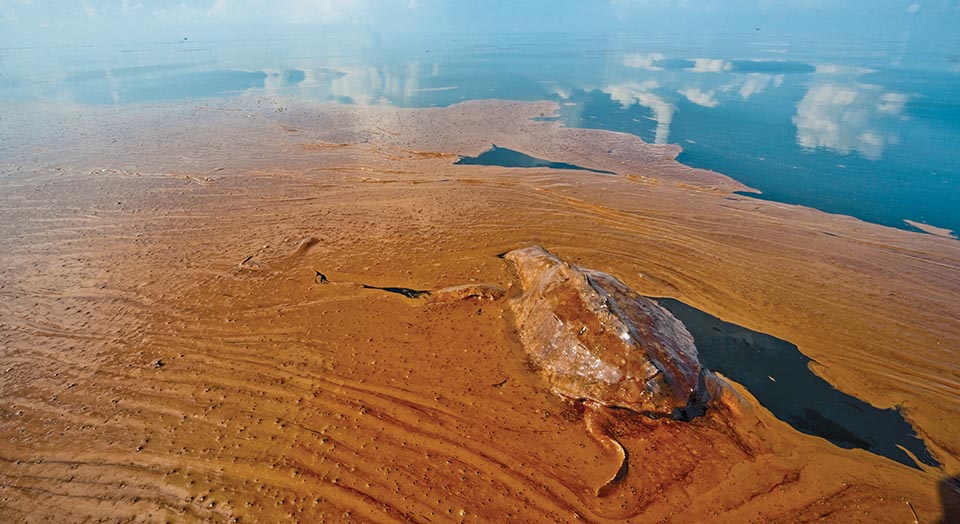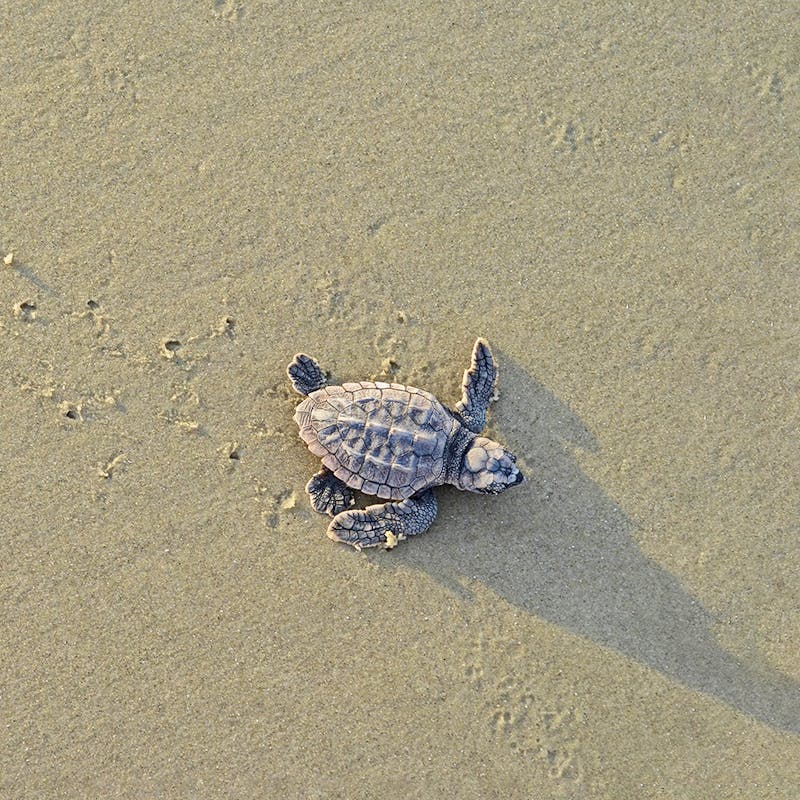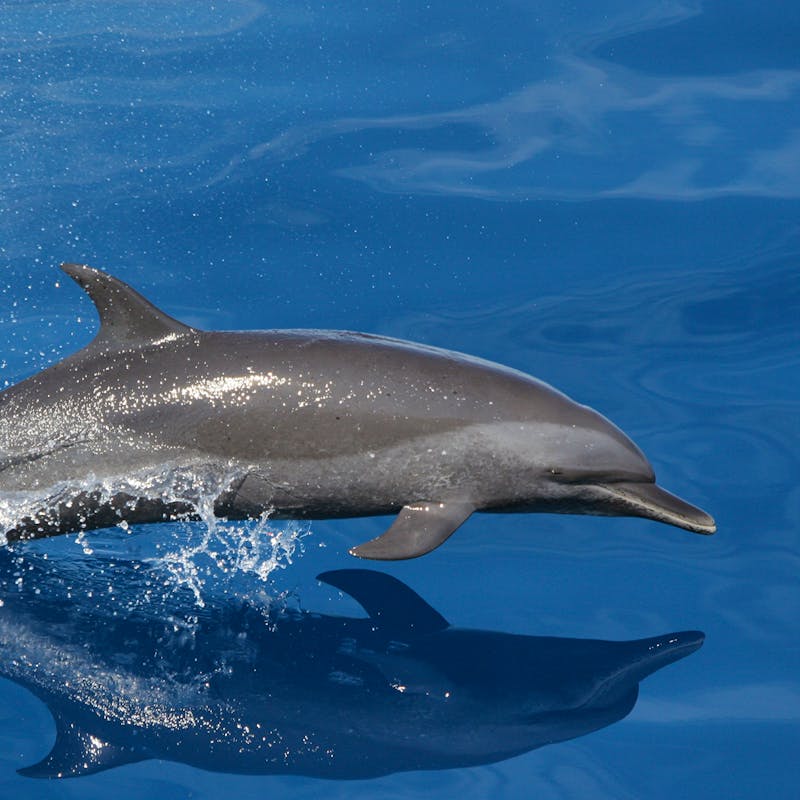The Trump administration’s unprecedented offshore drilling proposal would imperil sea life and seashores along almost the entire U.S. coastline
By Sharon Guynup
Cat Island National Wildlife Refuge was once a tiny island off the Louisiana coast that supported one of the largest bird-nesting grounds in the state for brown pelicans. At least 1,000 nested here. It was also an important rookery for roseate spoonbills, white ibises, least terns, wood storks and other species.
 Mississippi River floods reliably restocked the sloughs with fish, providing rich foraging habitat for wading birds and for the many birds that stopped for rest and sustenance during migrations. Mallards, green-winged teal and wigeons over-wintered here, and wood ducks and hooded mergansers were year-round residents. Water tupelo and bald cypress trees—some a century-old—provided cavities for bats to roost. The root system of eight-foot-tall mangroves literally held the island together.
Mississippi River floods reliably restocked the sloughs with fish, providing rich foraging habitat for wading birds and for the many birds that stopped for rest and sustenance during migrations. Mallards, green-winged teal and wigeons over-wintered here, and wood ducks and hooded mergansers were year-round residents. Water tupelo and bald cypress trees—some a century-old—provided cavities for bats to roost. The root system of eight-foot-tall mangroves literally held the island together.
But when the BP Deepwater Horizon exploded in 2010, about a third of the 215 million gallons of oil that spewed into the Gulf of Mexico made its way to Cat Bay and engulfed the pristine island refuge. Birds were reported to be literally choking in oil. The spill laid waste to the mangroves, which shriveled and died. Within three years—with tar balls from the spill still washing ashore—the mangrove roots decayed, and much of the island quickly eroded into the sea. In 2016, the island officially disappeared.
Deepwater was the largest oil spill in U.S. history, but spills are not uncommon, says Jane Davenport, a Defenders’ senior staff attorney. “Spills are an inevitable consequence of drilling. If there’s going to be drilling, there are going to be leaks. It’s not a matter of if—it’s when,” she says.
That’s the reason that a new offshore drilling plan has sparked broad backlash from many coastal states. Under the new “America-First Offshore Energy Strategy” unveiled by the Trump administration in January, vast swaths—some 90 percent—of the U.S. outer continental shelf could be auctioned off for oil and gas drilling in Atlantic, Pacific, Gulf of Mexico and Arctic waters. This plan would imperil America’s sea life and coastlines from Alaska to California, across the Gulf of Mexico and from Florida to Maine.
In his announcement, Interior Secretary Ryan Zinke stated that this new five-year plan offers the largest proposed sale of offshore drilling leases in U.S. history. It’s a radical, pro-industry change from the existing plan that protected 94 percent of the shelf, which lies offshore between state coastal waters and the deep-ocean U.S. territorial boundary.
The new plan includes areas that were thought to be permanently protected: President Obama’s five-year plan had taken the Arctic and the Atlantic off the table. And it comes on the heels of a proposed selloff made public in October that would auction oil and gas leases covering 76.9 million acres in the Gulf of Mexico, an area the size of New Mexico.
This dramatic rollback, mandated under President Trump’s April 2017 executive order, must undergo multiple phases of review, but the Interior Department hopes it will go into effect in 2019. The directive encourages government agencies to slash or circumvent regulations to avoid “burdens” that “unnecessarily encumber energy production.” It’s all part of a larger strategy to dramatically expand coastal drilling while simultaneously eradicating safeguards. Among them are actions that lower ocean-drilling safety standards, reduce funds for spill cleanups and remove protections for marine life—placing sea life, seashores and communities at even greater risk.
The drilling plan has prompted a massive outcry, with concerns over oil-soaked beaches, devastated marine wildlife, climate change impacts, destroyed fishing and tourism industries, damaged local economies, interference with military training exercises—and effects on human health.
Governors of 11 states—both Republicans and Democrats—have publicly opposed drilling off their coasts and vowed to fight. They’ve been joined by more than 150 municipalities, tens of thousands of local businesses, numerous environmental organizations, hundreds of thousands of commercial fishing families, commercial and recreational fishing associations—and even the Department of Defense. Battles in the courts and on Capitol Hill are looming.
Defenders joined a coalition of 64 organizations denouncing the plan, calling it a shameful giveaway that poses severe, unacceptable and irrevocable harm to oceans. The proposal would expose the Arctic waters—our last undeveloped ocean—to drilling, put the Atlantic coast on the chopping block for the first time since 1983, open the Pacific coast—which has not seen federal drilling for decades—and further threaten the already debilitated Gulf of Mexico.
There is no place where oil drilling has ever been done in a clean and safe way. Equipment fails. People make mistakes. Hurricanes take down oil platforms and rip apart pipelines. About 880,000 gallons of oil spill into oceans each year as part of “normal” U.S. drilling operations, says Kent Wimmer, Defenders’ Northwest Florida senior representative. And that’s not taking into account disasters like the massive Deepwater Horizon spill. Petrochemicals are toxic to all living things, poisoning birds, mammals, fish and even the microscopic plants and animals that form the base of the food chain. Exposure has been linked to many serious wildlife health problems, from liver and kidney failure and lowered disease immunity to cancer and poor reproduction rates—which further decimate populations.
The 1.9 million gallons of chemical dispersants that BP sprayed on the massive slick to break down oil into droplets magnified the toxicity by enabling oil to more easily enter plant and animal cells, according to a 2015 Government Accountability Project report.
The Deepwater disaster offered a tragic window into the immediate and long-term consequences of letting large quantities of oil loose in the marine environment. The initial death toll was massive. During the first three months after the spill, response teams found more than 600 dead sea turtles, all of which are endangered species. A higher but unknown number died and sank undetected. About one million birds died—some 800,000 coastal birds and 200,000 offshore birds.
Animals that are not killed immediately often suffer a slow death from debilitating illness and injury from initial and ongoing oil exposure. Oil doesn’t go away. It sinks to the bottom and is frequently stirred up by winds and strong tides. The farther up the food chain, the heavier the toxic load each of these animals carry.
Published research documented a mass die-off of Atlantic bottlenose dolphins from the Deepwater catastrophe. Eight years later, populations have still not recovered. Researchers have found that many suffer from chronic, life-threatening adrenal gland disease and lung infections. A 2015 National Oceanic and Atmospheric Administration (NOAA) report noted that “never have the dolphins experienced a die-off that has lasted as long, involved as many animals, or affected as many calves.”
Many species of fish developed lesions from swimming in oil-drenched waters. Scientists discovered hydrocarbons and dispersant residues in American white pelicans eggs in birds that nest as far away as Minnesota—and in the bloodstreams, feathers and eggs of loons that migrate to other states. The Gulf of Mexico is a critical migratory stopover and nesting area for hundreds of bird species.
In addition to spills, oil development presents other hazards to wildlife by increasing shipping traffic—and the risk of collisions with already imperiled whales—air pollution and ocean dumping of toxic debris. Further, pulling fossil fuels from the ground and burning them will only increase climate change impacts.
“We should look at the big picture and be curtailing our fossil fuels production, not opening up new areas,” says Aimee Delach, Defenders’ senior policy analyst for climate adaptation. “Other industries get it, which is why renewable energy and electric cars are proliferating. But the oil industry—and the Interior Department—are trapped in the past.”
Together, these factors threaten already imperiled species, from polar bears, walruses and belugas in the North Pacific to the Atlantic’s critically endangered North Atlantic right whales and Florida’s threatened manatees. A spill could be a death sentence for the Pacific Northwest’s last 76 southern resident killer whales, also called orcas, says Robb Krehbiel, Defenders’ Northwest representative. Oil spills from offshore drilling are also an immense threat to threatened southern sea otters in California. Oil mats their fur and they quickly die from hypothermia in chilly Pacific waters—or they succumb to organ failure from oil exposure.
Other recent oil industry-friendly proposals directly affect wildlife conservation. Among the greatest concerns, says Davenport, is a proposed amendment to the Marine Mammal Protection Act, which may soon be voted on by Congress. The “Streamlining Environmental Approvals” (or SEA Act, H.R. 3133) is intended “to reduce unnecessary permitting delays by clarifying associated procedures to increase economic development.”
The bill was crafted to facilitate seismic testing that uses sound waves to map undersea oil and gas reserves. Ships tow arrays of industrial-sized airguns that blast sound every 10 to 12 seconds for weeks or months at a time. These intense sound waves reverberate for hundreds of miles.
The process will cause serious harm to ocean life long before a drop of oil is pulled from the ocean floor, particularly to whales and dolphins that rely on sound to migrate, communicate with calves and their group and search for prey. Seismic blasting can literally blow out their ears, and as Davenport notes, “a deaf whale is a dead whale.”
Five companies have already applied for incidental harassment permits to run seismic tests on 92,000 miles of ocean in the Atlantic from Delaware to Florida during the next year alone. The SEA Act would pave the way for future seismic blasting with much less stringent regulatory safeguards by gutting critical sections of the Marine Mammal Protection Act (MMPA)—eliminating the law’s obligations to ensure that any activity has “negligible impact” on protected marine mammal species and will be “infrequent” or “unavoidable.” Meanwhile, the National Oceanic and Atmospheric Administration projected that seismic testing would “take” what it deemed small numbers—30 percent.
The SEA Act would also fast-track permit approvals to 120 days, too small a window for a sound scientific assessment. Permits could then be extended without review.
“This will essentially eviscerate the MMPA, says Davenport. “This is a direct legislative attack on bedrock laws protecting marine mammals.”
One of the casualties could be the critically endangered North Atlantic right whales that live and migrate along the Atlantic coastline. Fewer than 450 remain. Without serious conservation efforts, they could be functionally extinct within 20 years. Last year, in a letter to the National Marine Fisheries Service, scientists warned that “the additional stress of widespread seismic airgun surveys may well represent a tipping point for the survival of this endangered whale, contributing significantly to a slide toward extinction.”
But other rollbacks are also of serious concern, and December was a busy month for legislators looking for handouts to industry. As part of the tax overhaul, Congress opened the Arctic National Wildlife Refuge to oil and gas drilling. The administration then lifted offshore equipment safety rules and the need for equipment inspections and real-time monitoring of deep-ocean wells, measures that were put in place to prevent another Deepwater-scale blowout. “The multiyear process to make the technology safer is being rolled back exactly at the moment it’s needed most,” says Davenport. The Interior Department also halted a study of the offshore oil and gas inspection program intended to improve safety.
Another oil industry perk came on New Year’s Day. The companies will no longer need to pay a nine cent-per-barrel tax for a federal oil-spill cleanup fund, a tax that was imposed after the 1987 Exxon Valdez disaster.
“It’s death by a thousand cuts,” says Davenport. “We’re fighting a multifront war.”
There are a number of potential disincentives for oil companies to begin new ocean exploration drilling. There are numerous questions about the legality of many of these federal regulatory changes, including the Trump administration’s reversal of the Arctic and Atlantic leasing ban, possible violation of the Outer Continental Shelf Lands Act and more.
Individual states are also fighting back. Maine Sen. Susan Collins and nine other New England senators have introduced legislation to bar offshore drilling along their stretch of the East Coast. And under another law, the Coastal Zone Management Act, states can slow the leasing process, with lawsuits tying up oil company assets for years—or decades—with no guaranteed financial return.
Even if the administration sells leases in federal waters, California and other states control three miles of coastal waters, so they have the power to reject permits for oil pipelines running to oil platforms, holding stations and refineries.
Interior Secretary Zinke may have opened a loophole for states opposed to drilling on their coastlines. Five days after announcing the coastal leasing plan, he tweeted that he was excluding Florida because it is “unique and its coasts are heavily reliant on tourism as an economic driver.” It sparked a deafening outcry from other governors and members of Congress for similar exemptions.
And with crude prices low, it’s not clear how attractive these proposed leases are: Offshore drilling is expensive, especially in the remote Arctic.
There’s no good news in this five-year lease program, says Davenport. But the federally mandated approval process requires layers of review, allowing plenty of time for opponents to file legal challenges and blunt these reckless initiatives.
Defenders’ Wimmer sums it up well. “Multinationals get rich and local people clean up their mess. At this point, it’s damage control, which may mean taking it to the courts.”
Sharon Guynup writes on wildlife and environmental issues and is co-author of Tigers Forever: Saving the World’s Most Endangered Big Cat. She is a global fellow at the Woodrow Wilson International Center for Scholars and a National Geographic Explorer.
Photo caption: This sea turtle covered in oil is just one of the countless animals that suffered and died from the Deepwater Horizon catastrophe.
Only select articles from Defenders are available online. To receive 4 issues annually of the full award-winning magazine, become a member of Defenders of Wildlife!



